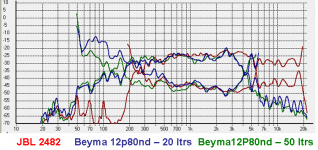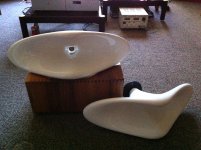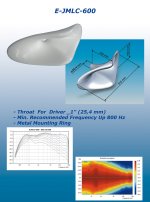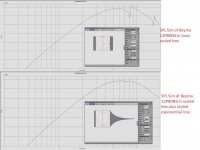It's difficult to quantify what I don't like about the sound presentation. The dynamics and a sense or air is what is missing for me. They are detailed and very quick, they sound like a good panel speaker, Maggie etc. I do think the integration into the room is a big unquantified factor also, probably along with the fact I am using as amps to drive them, as I don't have any dht's big enough.
It's difficult to quantify what I don't like about the sound presentation. The dynamics and a sense or air is what is missing for me. They are detailed and very quick, they sound like a good panel speaker, Maggie etc. I do think the integration into the room is a big unquantified factor also, probably along with the fact I am using as amps to drive them, as I don't have any dht's big enough.
Interesting. Your experience is very relevant to me as I also have a TPL-150H on top, and also worry about center to center distance to the midrange especially if using a horn, yet I would love to drive it with a SET and have dynamics and air. I thought about using a vertically narrow horn, asked here, but the feedback wasn't encouraging.
What amps are you using? My plan is to use 2A3 or 45 (top candidate at this time is Yamamoto) to actively drive the TPL and the midrange. And I have class-D to drive dual 10" below 400Hz + subwoofers.
Considering your experience and my comments above, which direction do you suggest I dig into?
- a single 6.5" or 8" direct radiator midrange 400-2000Hz
- MTM with 6.5" direct radiators
- a direct radiator inside a circular horn, or vertically narrow horn
- a compression driver inside a horn
- a different one?
Having done some extensive listening to both the IB midrange and my original horn loaded midrange, i have a few observations i want to share.
The differences i have been hearing (and not liking) seem to be all about the presentation - i think what they used to call a Voigt or Watts type sound stage, i prefer the former, where the soundstage is very enveloping, typical of horns. Where as the IB's have the point source presentation. Hope you undertand what i mean.
Secondly the Beyma IB's are very tight and have more detail than the midrange horns, changing the box volume as mentioned had no effect, removing some of the damping medium from within did make them more dynamic.
Thirdly amps - DHT's and IB's dont really work - even though my amps had enough juice to get to a reasonable db level. Better electrical damping and less stuffing seems to be the best approach.
What i want to understand is how can i replicate the sound stage of the horns with the IB? I assume its all down to directionality. I am assuming that the horns have a narrower field of dispersion, which to me is counterintuitive to the sound stage i want. All i can think is its room coupling, with the focussed singular listening point, minimising reflections etc.
The differences i have been hearing (and not liking) seem to be all about the presentation - i think what they used to call a Voigt or Watts type sound stage, i prefer the former, where the soundstage is very enveloping, typical of horns. Where as the IB's have the point source presentation. Hope you undertand what i mean.
Secondly the Beyma IB's are very tight and have more detail than the midrange horns, changing the box volume as mentioned had no effect, removing some of the damping medium from within did make them more dynamic.
Thirdly amps - DHT's and IB's dont really work - even though my amps had enough juice to get to a reasonable db level. Better electrical damping and less stuffing seems to be the best approach.
What i want to understand is how can i replicate the sound stage of the horns with the IB? I assume its all down to directionality. I am assuming that the horns have a narrower field of dispersion, which to me is counterintuitive to the sound stage i want. All i can think is its room coupling, with the focussed singular listening point, minimising reflections etc.
Having done some extensive listening to both the IB midrange and my original horn loaded midrange, i have a few observations i want to share.
The differences i have been hearing (and not liking) seem to be all about the presentation - i think what they used to call a Voigt or Watts type sound stage, i prefer the former, where the soundstage is very enveloping, typical of horns. Where as the IB's have the point source presentation. Hope you undertand what i mean.
Secondly the Beyma IB's are very tight and have more detail than the midrange horns, changing the box volume as mentioned had no effect, removing some of the damping medium from within did make them more dynamic.
Thirdly amps - DHT's and IB's dont really work - even though my amps had enough juice to get to a reasonable db level. Better electrical damping and less stuffing seems to be the best approach.
What i want to understand is how can i replicate the sound stage of the horns with the IB? I assume its all down to directionality. I am assuming that the horns have a narrower field of dispersion, which to me is counterintuitive to the sound stage i want. All i can think is its room coupling, with the focussed singular listening point, minimising reflections etc.
For the casual reader: please understand "IB" is a term used by some to simply mean a large sealed environment. It is not a true "infinite baffle".
First off, you are NEVER going to be able to replicate what a good horn can do. That's why the love affair exits to begin with. You can, however, get something approaching that sound, and leaving the typical d.r. signature behind. You have already made a HUGE discovery on how different amplifiers can make quite a bit of difference in sound quality (take that, Julian Hirsch!!)
Try using a high-quality Class-A solid state of somewhere between 25-50 watts. Directivity is the next aspect, which it appears you have already suspected. Do you remember "echo-muffs" ? That's what you need- very large close proximity acoustic absorbing devices. Placed either side of each speaker forming a angled plane to each, and extending ever so slightly forward of the front baffle board. You have to experiment with the rake angle.
That will get you closer. Good luck, and keep us posted !!
"Echo muffs" - if i have to have a couple of carbuncules on the side of my speakers i may as well have a horn. Not sure if i totally agree with your statement on amps - i would agree that a DHT isn't an apropiate amp for this application.
Back at the start of this experiement i was considering if i could get better integration with the midrange horn and TPL. Recently i have had some positive feedback from someone who has changed from a round horn to a "Yuchi" style one, and was poised to make sawdust making some, but stopped as i was concerned that the wider horizontal dispersion would have a negative effect. I think i will post a layout of my listening room, and people can sketch the optimal dispersion pattern i need.
Back at the start of this experiement i was considering if i could get better integration with the midrange horn and TPL. Recently i have had some positive feedback from someone who has changed from a round horn to a "Yuchi" style one, and was poised to make sawdust making some, but stopped as i was concerned that the wider horizontal dispersion would have a negative effect. I think i will post a layout of my listening room, and people can sketch the optimal dispersion pattern i need.
The La Cleach mid horn probably has a more controlled (smooth) directionality compared to the IB. However, at 350 Hz, the 2482 would probably have a lot more distortion than the IB, which confounds the "point source presentation" issues a bit, less distortion makes for more detail, but less dispersion control makes for less detail...What i want to understand is how can i replicate the sound stage of the horns with the IB? I assume its all down to directionality. I am assuming that the horns have a narrower field of dispersion, which to me is counterintuitive to the sound stage i want. All i can think is its room coupling, with the focussed singular listening point, minimising reflections etc.
Enough writing, going out to the frozen shop to continue horn experiments using a small full range driver, which might be the "best of both worlds".
Art
What a pity a good bi-radial wood horn is so expensive !
What could give a less intrusive (flater) 90x40° bi-radial horn with the 80x30° of the TplH above and the 12p80nd below ? 600 hZ to 2000 hZ (or more, Nothing is forbiden like using the AMT at higher range : >3000 hZ ?
What could give a less intrusive (flater) 90x40° bi-radial horn with the 80x30° of the TplH above and the 12p80nd below ? 600 hZ to 2000 hZ (or more, Nothing is forbiden like using the AMT at higher range : >3000 hZ ?
The La Cleach mid horn probably has a more controlled (smooth) directionality compared to the IB. However, at 350 Hz, the 2482 would probably have a lot more distortion than the IB, which confounds the "point source presentation" issues a bit, less distortion makes for more detail, but less dispersion control makes for less detail...
Enough writing, going out to the frozen shop to continue horn experiments using a small full range driver, which might be the "best of both worlds".
Art
I like where you are going with this idea. I have been wanting to do the same for quite some time ! Please keep us posted !
The La Cleach mid horn probably has a more controlled (smooth) directionality compared to the IB. However, at 350 Hz, the 2482 would probably have a lot more distortion than the IB, which confounds the "point source presentation" issues a bit, less distortion makes for more detail, but less dispersion control makes for less detail...
Enough writing, going out to the frozen shop to continue horn experiments using a small full range driver, which might be the "best of both worlds".
Art
cool
A domestic Synergy ? 2" apex for 4" cone (TC9 or 10F
For the 100 ~ 800 Hz , does a synergy détail the sound as good with its lateral ports Inside the horn than an IB 15 or 12" woofer like the Altec or JBL?
I ask myself what could give a 45 cm long bi-radiall horn for home integration with such cone driver like the Vifa or ScanSpeak as well ! Don't know if a bi-radiall brings enough spl from a 85 db sensivity driver ! a 98/100 db/1 meter should be enough for home & distorsion (for lowering cone mvts like in the xrq971's Trynergy) ?
Last edited:
Back at the start of this experiement i was considering if i could get better integration with the midrange horn and TPL. Recently i have had some positive feedback from someone who has changed from a round horn to a "Yuchi" style one, and was poised to make sawdust making some, but stopped as i was concerned that the wider horizontal dispersion would have a negative effect. I think i will post a layout of my listening room, and people can sketch the optimal dispersion pattern i need.
Dumb question: Would a narrower Yuichi horn (eg; 80° instead of 90°) ruin it? Couldn't an 80° Yuichi be made to match the 80° horizontal dispersion of the TPL-150H?
BTW, I had seen those horns before at the Yamamoto website and loved their looks and thought maybe there was a chance to pair them with the TPL in terms of center-to-center, but didn't know how they were called
Last edited:
It is also more important it glues the polar response of your 10"s/box combo in its highs... imho !
The difficulty with a planar is the spl is not decreasing with distance as a horn or a direct driver, so in each case you will have to setup the DSP/active amp for your ideal listening position !
my usual two cents...
The difficulty with a planar is the spl is not decreasing with distance as a horn or a direct driver, so in each case you will have to setup the DSP/active amp for your ideal listening position !
my usual two cents...
Last edited:
There was some suggestion, in a coupe of posts back, that the 12" IB would have a lower distortion than the JBL 2482, so i thought i would measure it.
Hopefully the trace is self explainatory.
It looks as if the distortion is worse from around 400 hz down, between the IB and the CD driver.
The suprise to me is the effect of cabinet size on the distortion, changing from a 20 ltr to a 50 ltr cabinet, has quite a difference at the lower end of the freq response. Maybe its not really a suprise?
Hopefully the trace is self explainatory.
It looks as if the distortion is worse from around 400 hz down, between the IB and the CD driver.
The suprise to me is the effect of cabinet size on the distortion, changing from a 20 ltr to a 50 ltr cabinet, has quite a difference at the lower end of the freq response. Maybe its not really a suprise?
Attachments
Very interesting read.
I use a Classé DR3b Class A power amp to drive the 12p80nd. In a 90L cabinet it is flat down to 50hz, measured. I closed the back port of the cab with damping material.
Its precisely the colorless , or neutral presentation, which in my view adds to the amazing timbre/neutrality of the TPL-150, which makes the 12p80nd such a great match.
I like also the wider dispersion, wich makes different sit positions less critical.
The fact that i have just two ways covering a wide frequency range, from 50hz to at least 15khz flat, is another plus.
Recently i switched back to my horns, but that did not last more than a couple of days.
The only altenative which i think is interesting is a MTM with Faital Pro W8N8-200. But as some have commented, MTM's have their own integration problems.....
I keep very happy , and see no reason to start tweaking and experimenting again.
Angelo
I use a Classé DR3b Class A power amp to drive the 12p80nd. In a 90L cabinet it is flat down to 50hz, measured. I closed the back port of the cab with damping material.
Its precisely the colorless , or neutral presentation, which in my view adds to the amazing timbre/neutrality of the TPL-150, which makes the 12p80nd such a great match.
I like also the wider dispersion, wich makes different sit positions less critical.
The fact that i have just two ways covering a wide frequency range, from 50hz to at least 15khz flat, is another plus.
Recently i switched back to my horns, but that did not last more than a couple of days.
The only altenative which i think is interesting is a MTM with Faital Pro W8N8-200. But as some have commented, MTM's have their own integration problems.....
I keep very happy , and see no reason to start tweaking and experimenting again.
Angelo
My wife likes the E-JMLC Mick Jagger Lips horns. 
Folks have experimented with sealed cabinets which use tapered rear volumes to reduce resonances. This sometimes allows "big box smooth" in a modest size sealed volume, which are able to provide enough rear cone air restoration force to "control/tighten" the larger X-displacement transients.
Folks have experimented with sealed cabinets which use tapered rear volumes to reduce resonances. This sometimes allows "big box smooth" in a modest size sealed volume, which are able to provide enough rear cone air restoration force to "control/tighten" the larger X-displacement transients.
Attachments
If such relationship do exist they would not be dominate effects - minimal at most. A smaller, stiffer box can easily utilize a heavier cone woofer. I've never been a fan of light flimsy cones. They usually have small magnets and voice coils as well. Give me a 4" coil and massive magnet and robust cone thank you.
- Status
- This old topic is closed. If you want to reopen this topic, contact a moderator using the "Report Post" button.
- Home
- Loudspeakers
- Multi-Way
- Advise on mid range driver



